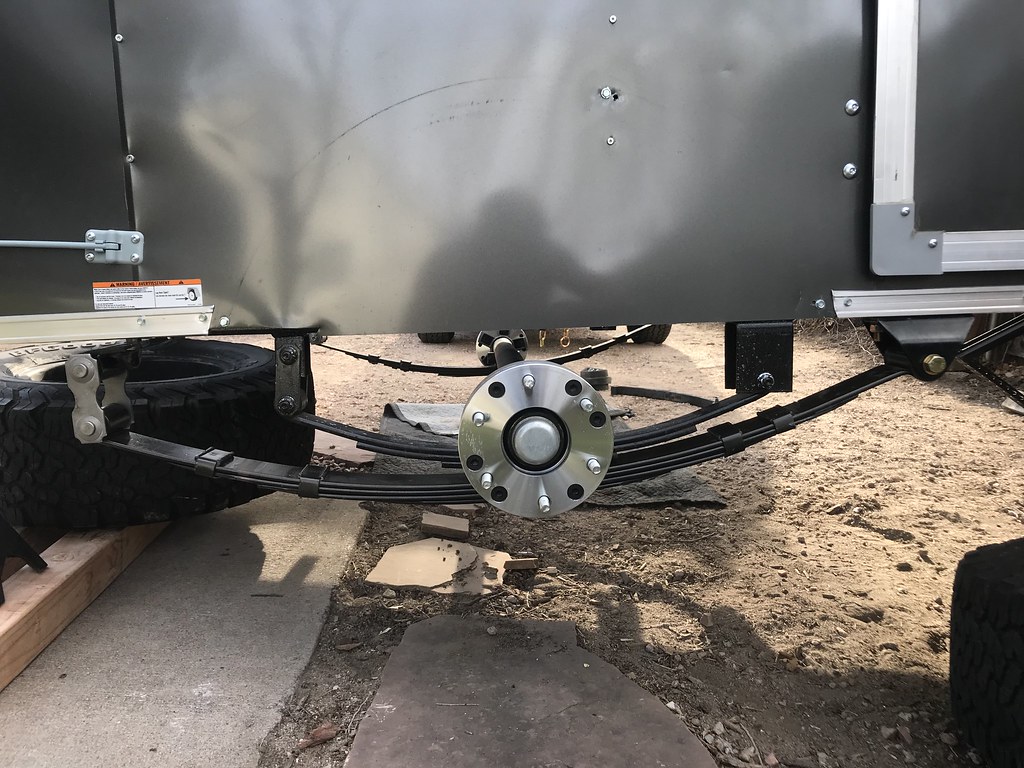Is there a reason why they aren't common place?
I would think that they would help with the tow vehicle ride too.







flboy wrote:All about costs I am willing to bet.

working on it wrote:from http://www.tnttt.com/viewtopic.php?f=39&t=66773&hilit=+bumpstop#p1198094...both times that I've experienced broken leaf springs (and the one-unmentioned shackle tear-off) there was no bumpstop to cushion/limit the flexing of the spring past its' working arc limits. In the case of Dave's spring breakage, the leaf spring had nothing limiting it from flattening out, or even reversing its' normal arced shape (except for the shock bottoming out), resulting in a severe jolt, and breakage. Now, even Timbren recognizes the problems of over-travel in their suspension, and sees the need to "progressively" absorb the energy before the absolute "stop". I chose not to use shock absorbers with my new leaf spring suspension (with relatively little travel), reasoning that the shock absorbers couldn't absorb enough energy in their limited motion to do much good before their absolute stop was reached.And, I was going to add a bumpstop to prevent the possible overtravel of the leaves past the flattened arc stage. So, I combined the functions of shock absorber and bumpstop into one, using a Daystar progressive bumpstop, made of resilient polyurethane, as an active part of the system (always in contact with, and following the motion of the axle); sorta like Timbren does with their component. I described my "active bumpstop suspension" in my thread: http://www.tnttt.com/viewtopic.php?f=35&t=59570#p1075076. I modified the Daystar bumpstop to be softer-acting (by cutting away the hard "bump" of the top of the piece, and curved the remaining body to slip-fit between my axle and frame (at full droop of the springs). With the top part of bumpstop so modified, the remainder relies on the two lower "ligaments" to progressively flatten out, before compression into the bottom layer, when the overtravel is finally prevented. I wondered how well it would work, as did many doubters on the forum, but I think it proved itself when I encountered a large chughole in the road at 75 mph. My truck and trailer both got bounced into the air, with my truck tires being the only damaged parts afterwards. In normal driving situations, I really haven't noticed any of the trailer bounce that I should be seeing, as a result of using too stiff of springs. In any case, the bumpstop at least kept the leaves from overflexing, preventing breakage. If I ever soften the suspension, and/or add conventional shock absorbers (if suspension travel becomes greatly increased), I will still use some form of progressive bumpstop to limit overtravel. I try different things, sometimes re-purposed from originally designed function, to do what I need them to. Sometimes it works....andworking on it wrote:my trailer now weighs 2025 ls, and I use a homebuilt version of Timbren's Active Off-Road Bumpstop (designed by me, and built and installed years before they started selling their's). from their website>>> Active Off-Road Bumpstops---Active Off-Road Bumpstops help you take control of your suspension travel. They’re designed with a progressive spring rate that can absorb the energy created when they “bottom out.” In other words, they allow for a smoother ride when they “bump” down on the axle. My bumpstops eliminate the roughness associated with using the leaf springs, being over capacity, by 32.5% (or 42% as compared to the axle capacity, itself), since I made them more flexible, and always acting upon spring travel, not just when "bottoming-out". I may, at some future date, get the lighter springs, if I unload the trailer's current load, but for now, they work fine, as-is.

flboy wrote:No more or less complex than 1 axle.. just more harware I'd think?
Sent from my SM-G935P using Tapatalk

hankaye wrote:aggie79, Howdy;
Thanks for providing those 2 links. Over on the RV forum I spend some time on I've read
more about the Dexter then the Lippert. Could be users choice, preference, who knows ...
Everyone has had good things to say but for most the reason for switching was something
broke on the factory version. As they are generally wrestling with something 3 or 4 times
the size and weight of our Cargo Trailers not much is said about quality of the ride after
the switch. Just some fodder for the thought box.
hank
Karebru wrote:...It looks like actually achieving a better ride, especially on a twin-axle, is a little more complicated than just a few bolt on parts....


Return to Cargo Trailer Conversions
Users browsing this forum: No registered users and 10 guests